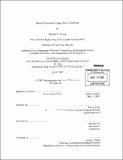Phase projection using three satellites
Author(s)
Yeung, Michael C. (Michael Chi-Hang)
DownloadFull printable version (8.882Mb)
Alternative title
Phase projection using 3 satellites
Other Contributors
Massachusetts Institute of Technology. Dept. of Electrical Engineering and Computer Science.
Advisor
Jin Au Kong and Bae-Ian Wu.
Terms of use
Metadata
Show full item recordAbstract
This study seeks to investigate various techniques used in Interferometric Synthetic Aperture Radar (InSAR) during the phase unwrapping process and the noise filtering step. In particular, as intuition would follow, we establish that the advantage of using three satellites over using just two in noise reduction means that using three satellites should be the way to go in all future work. In addition, this thesis does some in-depth investigation into the effectiveness of the following phase unwrapping methods: weighted least-squares phase unwrapping, branch-cut, and MAP dynamic programming phase unwrapping. The weighted least-squares unwrapping utilizes residues, which are points of inconsistencies on the interferogram, as a guide to assign weights when doing the weighting before the actual unwrapping step. Results show that weighted least square unwrapping fares the best in terms of mean RMS height error. We also introduce the notion of 2-D and 3-D Projection in our search for a simple, elegant solution to further reduce noise during our InSAR post-processing steps. 2-D Projection is shown to be a special case of 3-D Projection, and both require the presence of at least 3 satellites. Projection in general reduces noise in the system by utilizing the information provided by the configuration of the satellites to reduce the set of allowed phase points, thereby improving the robustness of the system to noise. Our results show that, for almost all cases, whether in the extremely small baseline distance or non-integer baseline ratios, using 3-D Projection gives much better results. Results are entirely simulation based, using the engineering tool MATLAB Version 7.0 developed by Mathworks. Root-mean-square errors will be used as the metric for comparison for most cases.
Description
Thesis (S.M.)--Massachusetts Institute of Technology, Dept. of Electrical Engineering and Computer Science, 2007. Includes bibliographical references (p. 92-95).
Date issued
2007Department
Massachusetts Institute of Technology. Department of Electrical Engineering and Computer SciencePublisher
Massachusetts Institute of Technology
Keywords
Electrical Engineering and Computer Science.